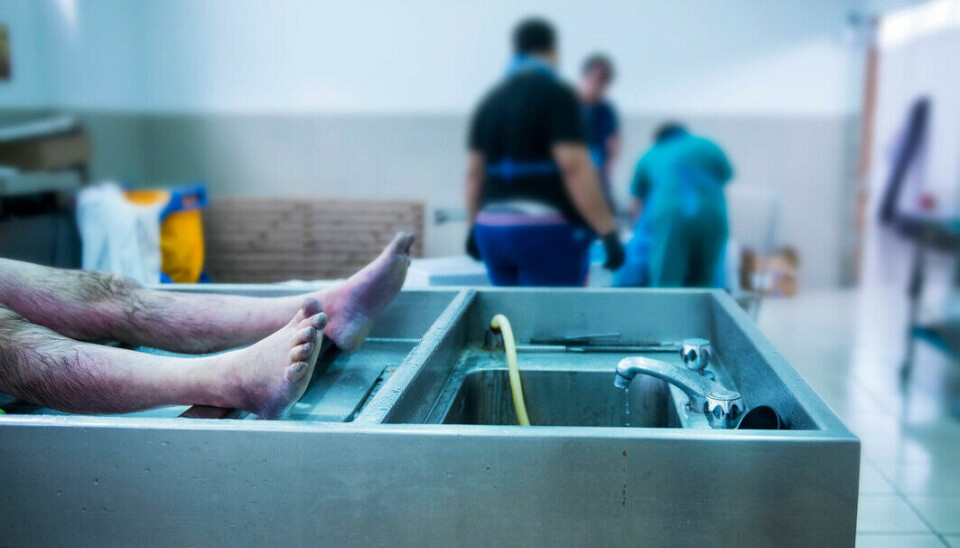
Many dead people have alcohol in their blood even though they didn't drink before dying
But where does the alcohol come from?
About 300 people die each year in Norway due to alcohol, according to the Norwegian Institute of Public Health.
Addiction and alcohol poisoning are among the most typical causes of death associated with alcohol.
According to MA – Rusfri Trafikk, an organisation that works against driving under the influence, a quarter of all fatal traffic accidents were also due to intoxication.
These are deaths where it would probably be natural to find alcohol in the blood of the deceased.
But researchers can actually find alcohol in the blood of far more people than just those who die from alcohol directly.
Even in those who had not consumed any alcohol before they died.
Several hundred with alcohol in their blood
Between 2,000 and 3,000 forensic autopsies are performed in Norway each year, according to a comment in the Journal of the Norwegian Medical Association (link in Norwegian).
The commen is written by Gudrun Høiseth and Jan Toralf Fosen, who are both chief physicians at the Department of Forensic Medicine at Oslo University Hospital.
During forensic autopsies, toxicological examinations are performed. The blood and other body fluids of the deceased are analysed for toxins and foreign substances.
In about 25 per cent of all these examinations, ethanol is detected in the blood of the deceased.
Many of these did not drink any alcohol in the time before they died.
The bodies must therefore have made the ethanol themselves.
How is it formed?
Alcohol is formed while the body decays.
Glucose is needed to make alcohol. When brewing beer, for example, yeast converts sugar to CO2 and alcohol, specifically ethanol, according to ScienceDirect.
In death, the body becomes a kind of brewery. Sugar, microorganisms, and adequate heat are needed to produce alcohol in a dead body.
More ethanol is formed in corpses in countries such as Saudi Arabia, and one of the reasons for this may be that a larger part of the population has diabetes, the chief physicians write.
Can you tell the difference?
An autopsy can tell the difference between a person who has drunk alcohol and one who has created it after death, the chief physicians state.
Substances are formed in the liver when you drink alcohol that do not appear if the alcohol is created in the body.
0.1 per cent of the alcohol you drink is converted into the substances ethyl glucuronide and ethyl sulfate, according to this study.
These substances are metabolites, i.e., substances that are formed during the breakdown of alcohol in the body.
These metabolites can therefore indicate whether someone has drunk alcohol or not.
Why is this important?
It is common for more alcohol to be created in bodies that have been exposed to traumatic injuries.
The crushing of organs in the abdomen can release a whole host of microorganisms into the rest of the body.
Because of this, violent accidents often indicate alcohol consumption even without any alcohol being involved at all.
A group of boys who died in a traffic accident where the driver had a blood-alcohol level of 1.27 is one of the examples the chief physicians point out.
The driver did not have the metabolites of alcohol in his liver and thus had not consumed any alcohol.
The violent accident caused significant damage to his organs which released a lot of microorganisms that turned the sugar in his body into alcohol.
By making sure that a good and thorough investigation is conducted, "unnecessary accusations of alcoholism at the time of death" can be avoided, the chief physicians write.
———
Translated by Alette Bjordal Gjellesvik.
Read the Norwegian version of this article on forskning.no
Reference:
Gudrun Høiseth and Jan Toralf Fose ‘Ethanol has been found in the body, but had the deceased consumed alcohol?’ (Etanol er påvist I liket, men hadde den avdøde drukket alkohol?) (link in Norwegian) Tidsskriftet.no, 2022

































